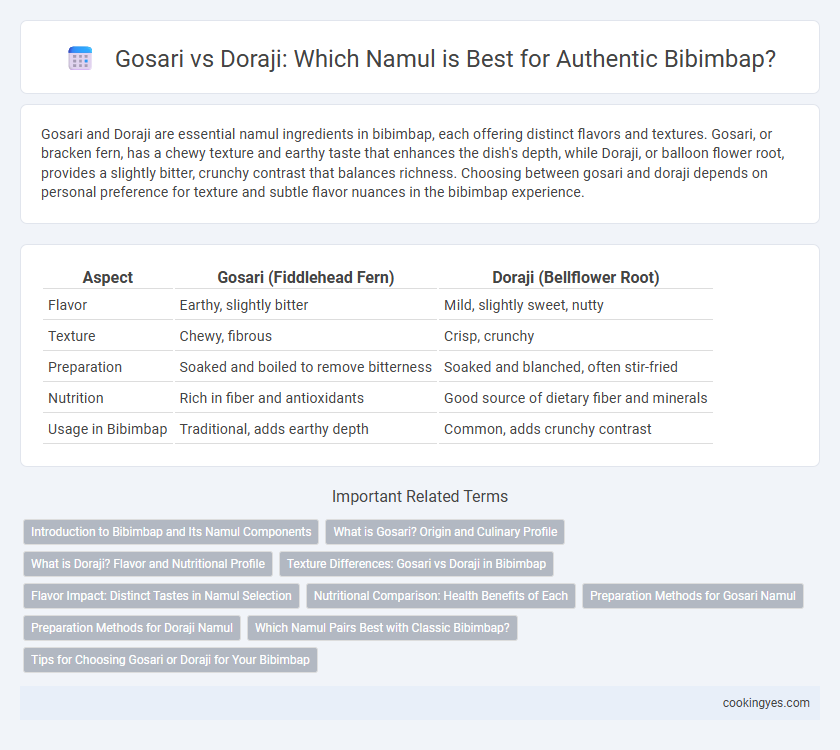Gosari and Doraji are essential namul ingredients in bibimbap, each offering distinct flavors and textures. Gosari, or bracken fern, has a chewy texture and earthy taste that enhances the dish's depth, while Doraji, or balloon flower root, provides a slightly bitter, crunchy contrast that balances richness. Choosing between gosari and doraji depends on personal preference for texture and subtle flavor nuances in the bibimbap experience.
Table of Comparison
| Aspect | Gosari (Fiddlehead Fern) | Doraji (Bellflower Root) |
|---|---|---|
| Flavor | Earthy, slightly bitter | Mild, slightly sweet, nutty |
| Texture | Chewy, fibrous | Crisp, crunchy |
| Preparation | Soaked and boiled to remove bitterness | Soaked and blanched, often stir-fried |
| Nutrition | Rich in fiber and antioxidants | Good source of dietary fiber and minerals |
| Usage in Bibimbap | Traditional, adds earthy depth | Common, adds crunchy contrast |
Introduction to Bibimbap and Its Namul Components
Bibimbap, a traditional Korean mixed rice dish, features a harmonious blend of various namul, or seasoned vegetable side dishes, that contribute distinct textures and flavors. Gosari, commonly known as bracken fern, offers a slightly chewy texture and earthy taste, enhancing the dish's complexity, while Doraji, or balloon flower root, provides a crunchy bite with a mild bitterness that balances the richness of the other ingredients. Both namul components are essential in creating the authentic sensory experience of bibimbap, highlighting Korea's culinary emphasis on diverse, natural flavors and nutritional variety.
What is Gosari? Origin and Culinary Profile
Gosari, also known as bracken fern, is a traditional Korean wild vegetable used extensively in bibimbap namul, prized for its earthy, slightly nutty flavor and chewy texture. It originates from the mountainous regions of Korea, where it is foraged and often dried before being rehydrated and seasoned for culinary use. Rich in dietary fiber and antioxidants, gosari adds a distinctive taste and nutritional value, contrasting with the crunchy, mildly bitter doraji root commonly paired in bibimbap.
What is Doraji? Flavor and Nutritional Profile
Doraji, known as balloon flower root, is a crunchy and slightly bitter ingredient commonly used in Bibimbap namul that adds texture and a unique earthy flavor. Rich in dietary fiber, vitamins B and C, and antioxidants, Doraji supports digestive health and boosts the immune system. Its distinct taste contrasts with the nuttier, firmer Gosari fernbrake, offering a lighter, refreshing element to the dish's overall flavor profile.
Texture Differences: Gosari vs Doraji in Bibimbap
Gosari (bracken fern) offers a chewy and slightly fibrous texture in Bibimbap namul, adding a hearty bite that contrasts well with softer rice and vegetables. Doraji (balloon flower root) provides a crisp, crunchy texture with a mild bitterness, creating a refreshing and unique mouthfeel. The choice between Gosari and Doraji significantly influences the textural complexity and overall sensory experience of Bibimbap.
Flavor Impact: Distinct Tastes in Namul Selection
Gosari offers a rich, earthy flavor with a slightly bitter undertone that enhances Bibimbap's complexity, while Doraji brings a crisp, mildly sweet, and slightly peppery taste that adds freshness to the dish. The distinct taste profiles of these namul vegetables significantly influence the overall flavor balance, with Gosari deepening the savory notes and Doraji introducing a bright, refreshing contrast. Selecting between Gosari and Doraji depends on whether a more robust or a lighter, aromatic dimension is desired in the Bibimbap experience.
Nutritional Comparison: Health Benefits of Each
Gosari (bracken fern) offers high fiber content and antioxidants, supporting digestive health and reducing inflammation in Bibimbap namul dishes. Doraji (bellflower root) is rich in saponins and vitamins C and B, promoting immune function and respiratory health benefits. Both ingredients provide unique nutrients that enhance the overall health benefits of a balanced Bibimbap meal.
Preparation Methods for Gosari Namul
Gosari Namul, a key ingredient in Bibimbap, requires thorough preparation involving soaking dried bracken fern for several hours to rehydrate and remove bitterness before boiling multiple times until tender. This process contrasts with Doraji Namul, which involves simpler cleaning, blanching, and light seasoning due to its softer texture. The meticulous soaking and boiling of Gosari ensure the desired chewiness and earthy flavor essential to authentic Bibimbap Namul.
Preparation Methods for Doraji Namul
Doraji namul, made from bellflower root, requires thorough preparation involving peeling, soaking, and blanching to remove bitterness and achieve the right texture for bibimbap. The soaking process, often done in cold water for several hours, reduces the root's toughness before it is boiled briefly and seasoned with garlic, sesame oil, and soy sauce. Proper preparation ensures doraji namul maintains a slightly crunchy texture and earthy flavor, distinguishing it from the softer, more fibrous gosari used in bibimbap namul.
Which Namul Pairs Best with Classic Bibimbap?
Gosari, or bracken fern, offers a slightly earthy and nutty flavor with a chewy texture that complements the warm, mixed rice and vegetables in classic bibimbap perfectly. Doraji, known as balloon flower root, provides a crisp, slightly bitter taste that adds a refreshing contrast but can overpower the dish's balanced flavors. For authentic bibimbap, gosari remains the preferred namul, enhancing harmony between ingredients without overwhelming the palate.
Tips for Choosing Gosari or Doraji for Your Bibimbap
When choosing between gosari and doraji for your bibimbap namul, consider gosari's earthy, slightly nutty flavor and chewy texture, which adds depth and heartiness to the dish. Doraji offers a crisp, slightly bitter bite with a refreshing aroma that balances richer ingredients and enhances overall flavor complexity. Prioritize gosari for traditional, robust profiles and doraji for a lighter, more vibrant contrast in your bibimbap.
Gosari vs Doraji for Bibimbap Namul Infographic

 cookingyes.com
cookingyes.com